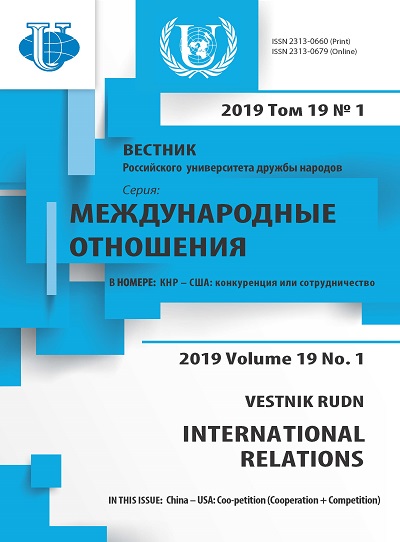Strategies of Foreign Universities on the ASEAN Educational Market
- Authors: Asmyatullin R.R.1
-
Affiliations:
- RUDN University
- Issue: Vol 19, No 1 (2019): China — USA: Coo-petition (Cooperation + Competition)
- Pages: 130-138
- Section: INTERNATIONAL EDUCATIONAL COOPERATION
- URL: https://journals.rudn.ru/international-relations/article/view/20857
- DOI: https://doi.org/10.22363/2313-0660-2019-19-1-130-138
Cite item
Full Text
Abstract
ASEAN is characterized by a steady growth of the economy, a growing middle class and a large population of school age, it is one of the most promising growing markets for the export of educational services. The scale of student mobility from this region has been constantly increasing. At the same time, there is a noticeable trend towards the diversification of its geography with the emergence of new destinations and the weakening positions of traditional countries like the USA, France and Germany. The ASEAN is becoming promising not only as the largest donor of foreign students, but also as a notable player in the global educational market as a study destination. Special attention is given to the analysis of the markets of Singapore and Malaysia, as the largest regional educational hubs. The strategies of these countries are based on the creation of special economic zones in the field of education, thereby attracting leading foreign universities. This approach has a positive effect on the quality of education, increasing the attractiveness of the country as a study destination. The purpose of this article is to analyze the specifics of the strategies of foreign universities in the ASEAN countries in order to identify the potential for export of educational services by Russian universities. The strategies of foreign universities are based on a number of mechanisms, such as setting up international branch campuses in ASEAN countries, opening joint universities and operating through the franchise system. The article identifies the main problems which constrain the expansion of Russian
About the authors
Ravil Ramilevich Asmyatullin
RUDN University
Author for correspondence.
Email: asmyatullin-rr@rudn.ru
PhD student, Department of International Economic Relations, assistant at the Institute of World Economy and Business, Peoples’ Friendship University of Russia (RUDN University)
References
- Aidrous, I.A. (2012). Competitiveness of Countries in the World Market of Higher Education. Nauchnoe obozrenie. Seriya 1. Ekonomika i pravo, 3—4, 128—132. (In Russian).
- Alfaro, L. & Ketels, C. (2016). Singapore’s Higher Education Cluster. Harvard Business School, 1—36.
- Chan, S.J. (2012). Shifting patterns of student mobility in Asia. Higher Education Policy, 25 (2), 207—224. DOI: https://doi.org/10.1057/hep.2012.3.
- Feuer, H.N. & Hornidge, A.K. (2015). Higher education cooperation in ASEAN: building towards integration or manufacturing consent? Comparative Education, 51 (3), 327—352. DOI: http://dx.doi.org/10.1080/03050068.2015.1031474.
- Filippov, V.M. (2015). Internationalization of higher education: major trends, challenges and prospects. Vestnik RUDN. International Relations, 3, 203—211. (In Russian).
- Knight, J. (2004). Internationalization remodeled: Definition, approaches, and rationales. Journal of Studies in International Education, 8 (1), 5—31. doi: 10.1177/1028315303260832.
- Knight, J. (2008). Higher education in turmoil. The Changing World of Internationalisation. Rotterdam, The Netherlands: Sense Publishers.
- Lek, D. (2014). Cross border higher education in ASEAN: Structures, policies, development and integration. ASEAN— Canada Research Partnership Working Paper Series, 4, 1—26.
- Marginson, S. (2011). Higher education in East Asia and Singapore: Rise of the Confucian model. Higher education, 61 (5), 587—611. DOI: https://doi.org/10.1007/s10734-010-9384-9.
- Ng, P.T. (2011). Singapore's response to the global war for talent: Politics and education. International Journal of Educational Development, 31 (3), 262—268. doi: 10.1016/j.ijedudev.2010.05.009.
- Stroupe, R. & Kimura, K. (2015). Opportunities and Challenges Across ASEAN: Looking Ahead to the ASEAN Economic Community. In: ASEAN Integration and Role of English Language Teaching, p. 1—12. doi: 10.5746/LEiA/ASEAN_Integ_ELT.
- Yavaprabhas, S. (2009). SEAMEO RIHED and higher education harmonization. JSPS AA Science Platform Program Seminar, January 23—25.
- Yavaprabhas, S. (2014). The Harmonization of Higher Education in Southeast Asia. In: Emerging International Dimensions in East Asian Higher Education. Springer Netherlands, p. 81—102. doi: 10.1007/978-94-017-8822-9.











